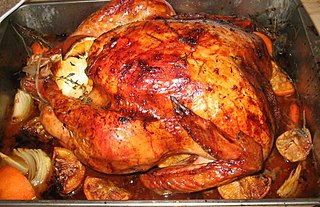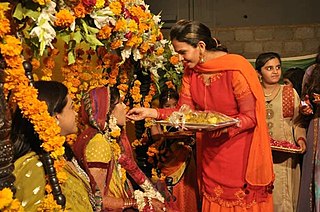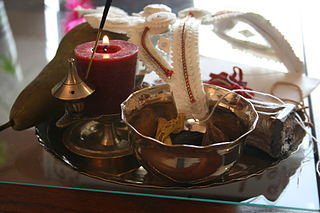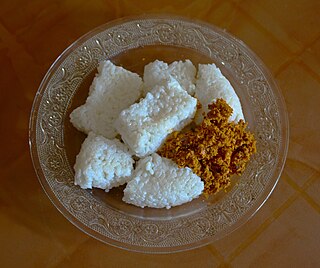
Osechi-ryōri are traditional Japanese New Year foods. The tradition started in the Heian period (794–1185). Osechi are easily recognizable by their special boxes called jūbako (重箱), which resemble bentō boxes. Like bentō boxes, jūbako are often kept stacked before and after use.

A baby shower is a party centered on gift-giving to celebrate the delivery or expected birth of a child. It is a rite of passage that celebrates through giving gifts and spending time together.

The first haircut for a human has special significance in certain cultures and religions. It can be considered a rite of passage or a milestone.

Dirty rice is a traditional Louisiana Creole dish made from white rice which gets a "dirty" color from being cooked with small pieces of pork, beef or chicken, green bell pepper, celery, and onion, and spiced with cayenne and black pepper. Parsley and chopped green onions are common garnishes. Dirty rice is most common in the Creole regions of southern Louisiana; however, it can also be found in other areas of the American South and referenced as "chicken and rice," "Cajun rice," or "rice dressing".

Jul or jol is the term used for the Christmas holiday season in Scandinavia and parts of Scotland. Originally, jul was the name of a month in the old Germanic calendar. The concept of jul as a period of time rather than a specific event prevailed in Scandinavia; in modern times, jul is a period of time stretching from the fourth Sunday before Christmas Eve, December 24, to (traditionally) mid-January at the date of Epiphany with the month of December and Christmas, and the week up to the New Year, as its highlight. The modern English yule and yuletide are cognates with this term.

Christmas dinner is a meal traditionally eaten at Christmas. This meal can take place any time from the evening of Christmas Eve to the evening of Christmas Day itself. The meals are often particularly rich and substantial, in the tradition of the Christian feast day celebration, and form a significant part of gatherings held to celebrate the arrival of Christmastide. In many cases, there is a ritual element to the meal related to the religious celebration, such as the saying of grace.
Nador (ನಾಡೋರ) or Nadavaru or Nadavar (ನಾಡವರ) is the name of a caste from Karnataka, India. Members of the castle are found primarily in the coastal areas of Uttara Kannada district, formerly known as North Canara, with many members also spread throughout the world. Caste members traditionally speak the Nadavar dialect of Kannada called Nadavar Kannada. They are a prominent agriculture community of the Uttara Kannada district of Karnataka, India.

A Bengali Muslim wedding is a Bengali wedding in accordance to Muslim faith.

Marriage in Pakistan pertains to wedding traditions established and adhered by Pakistani men and women. Despite their local and regional variations, marriages in Pakistan generally follow Islamic marital jurisprudence. Marriages are not only seen as a union between a husband and a wife, but also an alliance between their respective families. These traditions extend to other countries around in the world where Overseas Pakistani communities exist.

Punjabi wedding traditions are a strong reflection of Punjabi culture with ritual, song, dance, food, and dress that have evolved over centuries.

A Zoroastrian wedding is a religious ceremony in Zoroastrianism in which two individuals, a man and a woman, are united. In Zoroastrianism, marriage within the community is encouraged, and is greatly favored in religious texts. The following information will detail ceremony procedures and traditional processes for a Zoroastrian wedding.
Chinese pre-wedding customs are traditional Chinese rituals prescribed by the 禮記 (láih gei, the 儀禮 (yìh láih and the 白虎通 condensed into a series of rituals now known as the 三書六禮. Traditionally speaking, a wedding that incorporates all six rites is considered a daaih chéui.

A naming ceremony is a stage at which a person or persons is officially assigned a name. The methods of the practice differ over cultures and religions. The timing at which a name is assigned can vary from some days after birth to several months or many years.

The annaprashana, also known as annaprashana vidhi or annaprashanam, is a Hindu rite of passage (Saṃskāra) that marks an infant's first intake of food other than milk. The term annaprashana means 'eating of cooked rice'. In Vedic Hindu culture, the child cannot eat rice until the annaprashana has occurred. Importance is given to rice because of its symbolism as a life-sustaining food and a sacred food in the form of kheer. The annaprashana remains an important milestone and the ceremony is celebrated in Bangladesh, Nepal and India. It is also known as mukhēbhāt in West Bengal, cōṟūṇŭ in Kerala, and bhāt khulai in Himachal Pradesh. In Nepal, it is also called pasni.

Kiribath is a traditional Sri Lankan dish made from rice. It is prepared by cooking rice with coconut milk, hence this name, and can be considered a form of rice cake or rice pudding. Kiribath is an essential dish in Sri Lankan cuisine. It is very commonly served for breakfast on the first day of each month and also has the added significance of being eaten for any auspicious moment throughout one's lifetime which are marking times of transition. It is one of the more renowned traditional dishes in Sri Lanka.
Korean birthday celebrations or Dol are one of the important facets of Korean culture. When a person reaches an important age in his or her life, Koreans have unique celebrations to mark these milestones. Dol means it has been 365 days since the baby's birth.

Christmas is celebrated throughout December and traditionally until St. Knut's Day on January 13. The main celebration and the exchange of gifts in many families takes place on Christmas Eve, December 24. The Feast of St. Lucy, a high point in the Swedish Christmas season, is celebrated during Advent, on December 13.
Weddings in Myanmar, considered auspicious occasions in Burmese culture, reflect various ethnic, religious, and regional traditions. Depending on an individual's family social economic status, personal preferences and titles held, Burmese weddings can be religious or secular, and extravagant or simple. Wedding expenses are covered by the groom's family. Myanmar is a predominantly Buddhist country, and many wedding customs and traditions are influenced by Buddhism.
New Year's foods are dishes traditionally eaten for luck in the coming year. Many traditional New Year dishes revolve around the food's resemblance to money or to its appearance symbolizing long life, such as long noodles or strands of sauerkraut. Some cultures and religions have evolved complex food traditions associated with the new year.













